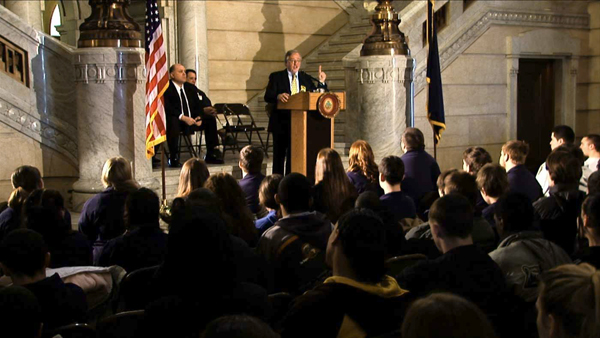Kids for Cash is a Frontline-style documentary that adds considerable behind-the-headlines insight from the perspectives of the families, the investigators, and the accused, despite the frustrating blank holes that are filled with rage against the machine of injustice.
The title was the media’s lurid shorthand for the January 2009 news breaking out of a small town in northeastern Pennsylvania, where a judge was sentencing kids to a privately run detention center in exchange for kickbacks. But director Robert May parses out that the story unfolding in his home region was more complicated. For starters, the accused, Judge Mark Ciavarella, had been sending teenagers into the juvenile justice system since he was first elected judge of the Luzerne County Court in 1995, and then reelected 10 years later, before the county started using new private facilities in 2005.
Ciavarella ran on a tough, scared-straight platform against youthful offenders (who back in the day were called juvenile delinquents) that he honed further when, the film says, the 1998 Columbine, Colorado, school shooting scared authorities around the country to react with zero tolerance for violence, perceived threats of violence, or, more disturbingly, what some would just consider immature teenage acting up. As seen in clips, Ciavarella made a point of sternly speaking to every high school in his jurisdiction, telling students this counted as a first warning.
Interviews with a few of the 3,000 teens who were sentenced in Ciavarella’s fast-paced court are illustrated with happy school and home photographs as they discuss the incidents that sent them to court and the disastrous impact on their lives. (They put the most positive spin on their misbehavior.) One high school junior was set up with drugs by his dad to teach the son a lesson not to keep on drinking. Other “crimes” range from a 14-year-old having unknowingly bought a stolen scooter to another 14-year-old posting a satirical Website mocking her school’s vice principal. To all their surprise, they eventually served sentences up to as much as seven years in various juvenile facilities.
When one parent reached out for help to the Juvenile Law Center, the lawyers focused on the fact that 54 percent of the young people were pressured to waive their right to counsel. (They got the Website protestor out after a few months.) The local public defender shrugs that it seemed about equal the number who used a lawyer and who didn’t. His attitude seems to be a business-as-usual recognition that it doesn’t seem so scandalous in terms of how the criminal justice system grinds through huge case loads, except that young people are involved and, unfortunately, their futures are permanently damaged. (There are no comparisons given to other courts of any kind elsewhere.)
The interviewees are confusingly inconsistent about whether educational opportunities were even offered in the facilities, while it seems likely that some probably had various learning disabilities. They certainly found out how to be criminals there when they were frequently returned for additional sentences after being turned in by zealous parole officers for any infraction. The officers, in noncommittal testimony at an investigative commission, shrug that they were just doing their jobs. The documentary implies that the judge set the tone for the entire juvenile justice system. No one at any of the detention facilities that the youth were sentenced to is interviewed.
With reports and photographs showing awful conditions at the public detention center, Judge Ciavarella thinks he had good intentions when he set about to have a new one built. (Where the interviewees actually served isn’t clearly identified other than repeated images of barbed wire fences.) But Judge Michael Conahan convinced him that strapped government budgets would preclude a public investment, and so he suggested another solution. Private prison corporations (as Michael Moore already sardonically showed more clearly in 1989 in Roger and Me) want assurances of sufficient inmates to support their profits. Judge Ciavarella’s longtime, consistent, and continuing record of sentencing was enough of a guarantee.
But dogged investigative reporters with the Times Leader figured out that Judge Conahan had a tangled set of businesses closely associated with grateful contractors and construction companies. (This film is also a tribute to local journalism). The filmmakers’ coup is to get extended, thoughtful interviews with both judges while extensive negotiations go on with local and federal prosecutors while the men weigh pleading guilty, going to trial, and then facing sentencing. Against his lawyer’s advice, Ciavarella explains that the construction company offered him “a finder’s fee” for the project, and, incredulously, he says he asked: “Is this legal?” He was assured a percentage was accepted practice—all $2 million plus for both judges to share, which was suspiciously kept off the books through Conahan’s complicated accounting—and later turned into the headline as “kids for cash.”
The tearfully furious parents have no interest in the niceties of what laws the judges broke. They bitterly blame Ciavarella for any and all misfortunes in their children’s lives, one of which led to a tragic end. Though the documentary was supported by foundations working for reforms in the juvenile justice system, the scandal distracts from consideration of this underlying issue of the tough sentencing and incarceration of people under 21. Currently in theaters and on demand, Trevor White’s Jamesy Boy biopic, about a Baltimore teen who was mentored out of a similarly escalating series of such institutions, usefully complements the documentary. It shows the difficulties young people face once they get caught up in a courtroom like Judge Ciavarella’s.







Leave A Comment